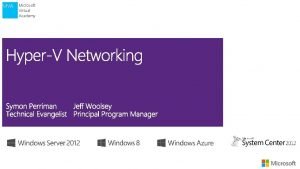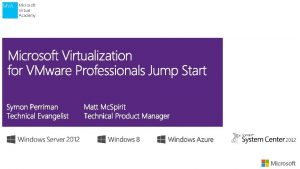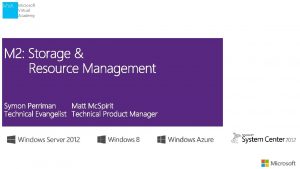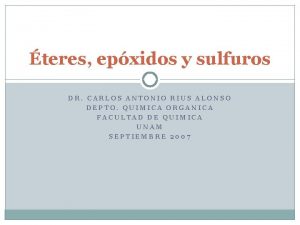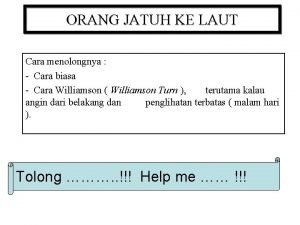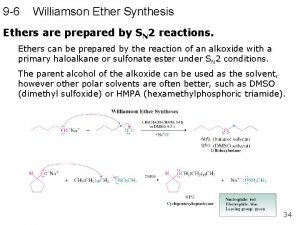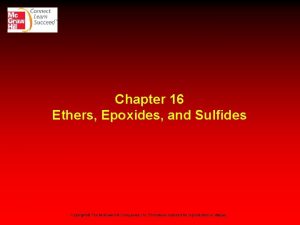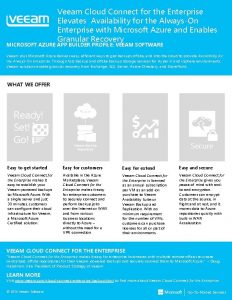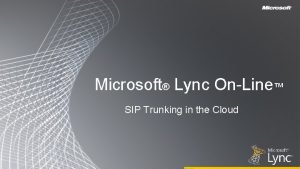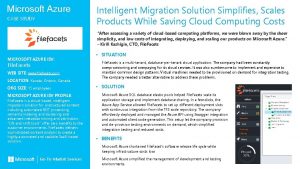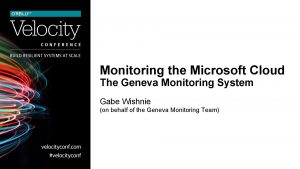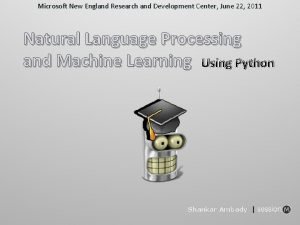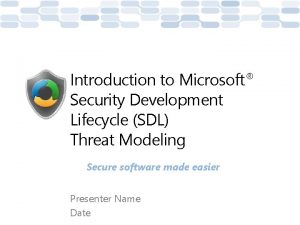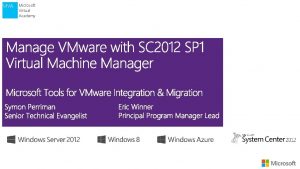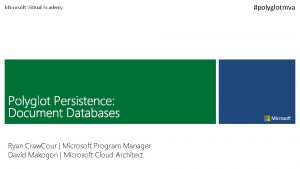Microsoft Virtual Academy TestDriven Development Sachi Williamson Cloud






































![Anatomy of a unit test [Test. Method()] public void When. XHappens_Given. Y_Result. Should. Be. Anatomy of a unit test [Test. Method()] public void When. XHappens_Given. Y_Result. Should. Be.](https://slidetodoc.com/presentation_image/39c4d3ae63e8e498d6044375e8a003a3/image-39.jpg)





























![Metric: cyclomatic complexity bool Parse. Command. Line(string[] args) { if (args. Length == 0) Metric: cyclomatic complexity bool Parse. Command. Line(string[] args) { if (args. Length == 0)](https://slidetodoc.com/presentation_image/39c4d3ae63e8e498d6044375e8a003a3/image-69.jpg)






















- Slides: 91

Microsoft Virtual Academy Test-Driven Development Sachi Williamson, Cloud Dev. Ops Consultant Steven Borg, Co-Founder and Strategist

Sachi Williamson • Cloud Dev. Ops Consultant at Northwest Cadence • Sachi. Williamson@nwcadence. com | @sawpresto • Product owner for NWC Knowledge Library product • Enjoys training and implementing continuous delivery pipelines • Biases: • Believes that “one size fits all” doesn’t work @sawpresto • “Failures” are learning opportunities – especially as an ice hockey goalie

Steven Borg • Co-Founder and Strategist at Northwest Cadence • Steven. Borg@nwcadence. com | @stevenborg • Presenter at several Microsoft Virtual Academy sessions • Lean software development, Git, Kanban and other topics • Microsoft ALM MVP for 11 years • Biases: • Prefer starting with the ‘big picture’ @stevenborg • Enjoy math and think it’s both fun and useful

Agenda Types of automated tests Working with legacy code Test-Driven Development in a nutshell TDD Patterns and Practices Unit testing and Test-Driven Development Extending TDD Advanced Unit Testing What qualities make up good tests?

Setting expectations

Join the MVA community!

Microsoft Virtual Academy Test-Driven Development in a nutshell

“Test Driven-Development: Clean code that works. ” – Ron Jeffries

Test-Driven Development Integrate testing into the development process Tests define what code will do Tests come from specifications Code

Two simple rules: Write new code only if an automated test has failed Eliminate duplication

Red/Green/Refactor Write a failing unit test. Red Refactor your draft code into a final version Code just enough to make the unit test pass Refactor Green

Red/Green/Refactor Write a new test Start Refactor as needed Run the test (Pass) Write the target code Compile Fix compile errors Run the test (Fails)

Red/Green/Refactor - revisited Write a failing unit test. Write a Test Refactor your draft code into a final version Make it Right Make it Run Code just enough to make the unit test pass

The steps 1. 2. 3. 4. 5. Quickly add a test. Run all tests and see the new one fail. Make a little change. Run all tests and see them succeed. Refactor to remove duplication

Who is this for? Developers who want to write better code Programmers who want to have confidence in code

Why does TDD work? Reduces defects by finding and fixing bugs earlier Shortens feedback loop on design decisions

Value prop of TDD Predictable process for development More intentional development Improve long-term maintainability of both code and tests Guarantee good unit test coverage of your code


Fibonacci Designing the Fibonacci in C#


Bowling Kata Exercise for using test-driven development with a commonly-known activity Popularized by Uncle Bob Martin

Bowling Kata - Scoring 10 frames 2 rolls of the ball to knock down 10 pins Score for each frame = Total number of pins knocked down + bonus for strike/spare Spare = All 10 pins knocked down in 2 rolls Bonus = Number of pins knocked down in next roll Strike = All 10 pins knocked down on first try Bonus = Value of next 2 rolls In 10 th frame, if spare or strike, can roll an extra time (up to 3) https: //commons. wikimedia. org/wiki/File: Bowlstrike. PNG

Bowling Kata - Design Class named “Game” roll (pins: int) – called each time player rolls a ball, argument is number of pins knocked down score() : int – called only at end of game, returns total score

Bowling Kata - Design

Bowling Kata Designing the Bowling Kata in C#

Test-Driven Development by Example Test-Driven Development By Example by Kent Beck http: //ecx. images-amazon. com/images/I/51 H 4 Na. RMF 4 L. _SX 258_BO 1, 204, 203, 200_. jpg

Test Driven Development isn’t a silver bullet.

Microsoft Virtual Academy Types of automated tests

The testing tree

Types of automated tests Unit tests Integration tests User Interface (UI) tests Web performance tests Load tests

Unit tests – a definition A unit test is an automated piece of code that invokes a unit of work in the system and then checks a single assumption about that behavior of that unit of work. What makes a good unit test?

Integration tests – a definition An integration test validates two or more dependent software modules as a group in multiple ways. What makes a good unit test?

Automated UI tests – a definition An automated user interface test drives the application UI to validate user specifications. What makes a good automated UI test?

Web performance tests – a definition A performance test validates an application’s responsiveness, throughput, reliability, and scalability. What makes a good performance test?

Load tests – a definition A load test puts demands on a system to determine behavior under varying levels of load, identify bottlenecks, and validate expected performance. What makes a good load test?

Microsoft Virtual Academy Unit testing and Test-Driven Development

Unit tests – a definition A unit test is an automated piece of code that invokes a unit of work in the system and then checks a single assumption about that behavior of that unit of work. What makes a good unit test?

Another definition of a unit test From The Art of Unit Testing by Roy Osherove: Unit test – An automated piece of code that invokes the method or class being tested and then checks some assumptions about the logical behavior of that method or class. A unit test is almost always written using a unit-testing framework. It can be written easily and runs quickly. It’s fully automated, trustworthy, readable, and maintainable.
![Anatomy of a unit test Test Method public void When XHappensGiven YResult Should Be Anatomy of a unit test [Test. Method()] public void When. XHappens_Given. Y_Result. Should. Be.](https://slidetodoc.com/presentation_image/39c4d3ae63e8e498d6044375e8a003a3/image-39.jpg)
Anatomy of a unit test [Test. Method()] public void When. XHappens_Given. Y_Result. Should. Be. Z() { //arrange Thing new. Thing = new Thing(); //act new. Thing. do. Something(); //assert Assert. Are. Equal("Actual", new. Thing. to. String()); } Indicates a test method Descriptive method name Set up the variables & objects for the test Perform the test action(s) Assert that the expected result occurred.

Unit Tests must be. . . Automatic Repeatable Available

The power of unit tests Reduce technical debt. Identify coupled code. Enable refactoring without fear. Document what your code really does. Improve automated builds.

Use the framework you want to use In the box support for Third party plugins

Microsoft Virtual Academy Advanced Unit Testing


Stubs External dependencies – Object in system that code under test interacts with and over which you have no control (e. g. file systems, threads, memory, libraries) Stub – Controllable replacement for existing dependencies. Test code without dealing with dependency directly Example: Training astronauts into space

Mock Objects Isolate your test to a unit’s scope Control the behavior of other code being called Keep from calling externals you don’t want to hit (or must not hit) during test execution Stubs != Mocks

Stubs vs. Mock Objects From Martin Fowler’s article, “Mocks aren’t stubs: ” Stubs – Provide canned answers to calls made during the tests, usually not responding at all to anything outside what’s programmed in for the test. Mocks – Objects pre-programmed with expectations which form a specification of the calls they are expected to receive. Stubs -> state verification Mocks -> behavior verification http: //www. martinfowler. com/articles/mocks. Arent. Stubs. html

Stubs vs. Mock Objects (cont. ) Stubs Mocks http: //www. martinfowler. com/articles/mocks. Arent. Stubs. html

Isolation Frameworks - Rhino Mocks Open source. NET dynamic mocking framework https: //www. hibernatingrhinos. com/Oss/rhino-mocks/learn/Usage/assert-that-a-method-is-called-with-a-value-in-expected-state

Isolation Frameworks - Moq Another. NET mocking framework for. NET Provides Linq to Mocks Doesn’t differentiate mocks from stubs

Isolation Frameworks Stubs and Mocks with Moq

Stubs vs. Mocks vs. Fakes From Martin Fowler’s article, “Mocks aren’t stubs: ” Stubs – Provide canned answers to calls made during the tests, usually not responding at all to anything outside what’s programmed in for the test. Mocks – Objects pre-programmed with expectations which form a specification of the calls they are expected to receive. Fakes – Objects that actually have working implementations but usually take some shortcut which makes them not suitable for production (e. g. in-memory database) http: //www. martinfowler. com/articles/mocks. Arent. Stubs. html

Shims Modifies the compiled code of application at runtime Instead of making specified method call, runs shim code that test provides Can be used to replace calls to assemblies that you can’t modify (e. g. . NET assemblies)

Stubs vs. Shims Stubs faster than shims Stubs can implement interfaces only (not static methods, non-virtual methods, sealed virtual methods, etc. ) Stubs can only replace visible methods, shims can replace calls to private methods if all types on method signatures are visible Stubs -> Isolate from dependencies within codebase Shims -> Isolate from 3 rd party components that don’t have a testable API

Isolation Frameworks - Microsoft Fakes (was Moles) Shims are a sledgehammer for legacy code temporary tests rewrite Do not use Shims to test your own new code! immediately refactor immediately

Isolation Frameworks Shims and Stubs with Microsoft Fakes

Microsoft Virtual Academy What qualities make up good tests?

Bad tests, bad designs Design smells: Long setup code Setup duplication Long running tests Fragile tests

What makes up a good unit test? Automated and repeatable Simple to implement Maintainable Anyone should be able to run it Runs at the push of a button (or automatically) Runs quickly

What should you test? Conditionals Loops Operations Polymorphism Code that you write (generally)

When should you delete tests? If two tests are redundant, decide with this criteria: Never delete a test if it reduces your confidence in the behavior of the system. If you have two tests that execute the same path through code but speak to different scenarios, leave them alone. If still redundant, delete the least useful of the two.

Microsoft Virtual Academy Working with legacy code

There’s no easy solution to test legacy code.

Factors that affect testing legacy code Coupling (the higher the coupling, the harder to test) Type of application that is being used Cost of refactoring Unwillingness to change


Metric: class coupling Business Logic GUI Transaction Customer Account

Metric: class inheritance Component Control List. Control Combo. Box Label List. Box Link. Label

Metric: lines of code 1 2 3 4 5 6 7 -9 static class Program { #region Application Entry Point /// <summary> /// The main entry point for the application. /// </summary> [STAThread] static void Main(string[] args) { Application. Enable. Visual. Styles(); Application. Set. Compatible. Text. Rendering. Default(false); Workflow(args); } #endregion #region Static Methods /// <summary> Primary workflow for the application. </summary> /// <param name="args"> Command line arguments. </param> private static void Workflow(string[] cmdargs) { // Collect the list of command line arguments List<string> args = new List<string>(cmdargs); // Show usage syntax if the user so asks if (Use. Arg(args, "/? ")) { Show. About(); return; }
![Metric cyclomatic complexity bool Parse Command Linestring args if args Length 0 Metric: cyclomatic complexity bool Parse. Command. Line(string[] args) { if (args. Length == 0)](https://slidetodoc.com/presentation_image/39c4d3ae63e8e498d6044375e8a003a3/image-69.jpg)
Metric: cyclomatic complexity bool Parse. Command. Line(string[] args) { if (args. Length == 0) { Show. Help(); return false; } for (int i = 0; i < args. Length; i++) switch (args[i]) { case "/? ": Show. Help(); return false; case "/input": if (args. Length > i && File. Exists(args[i + 1])) Input. File = args[i++]; break; case "/c": Collapse = true; break; } return true; }

Metric: maintainability index overall indication of complexity by aggregation of several factors lines of code cyclomatic complexity computational complexity used on the windows base code

Creating Intelli. Tests in Visual Studio 2015

Further resources for testing legacy code Working effectively with legacy code by Michael Feathers http: //ecx. images-amazon. com/images/I/51 H 6 SHy 6 g 2 L. _SX 258_BO 1, 204, 203, 200_. jpg

Refactoring, in 464 pages Refactoring: Improving the Design of Existing Code by Martin Fowler http: //ecx. images-amazon. com/images/I/512 -a. Yx. S 4 ML. _SX 258_BO 1, 204, 203, 200_. jpg

Microsoft Virtual Academy TDD Patterns and Practices

Red/Green/Refactor Write a failing unit test. Red Refactor your draft code into a final version Code just enough to make the unit test pass Refactor Green

Red Patterns Starter Tests – start with the simplest possible test to keep it simple Regression Tests – every time you have a bug, start with a test to prove the bug Smaller Tests – when it takes too long to ‘get to green’, create a smaller test first Mock Objects – fake version of objects which rely on expensive, complicated or external resources Broken Test / Clean Check In

Green Patterns Triangulate – abstract only when you have two or more examples Fake it – implement functionality with a constant to get started Obvious implementation – if the implementation is obvious, just do it (quickly) One to Many – when working with collections, start with a single element Fixture – refactor repeated code into a setup method that is called for each test

Refactor Patterns Design patterns – know your Gang of Four design patterns SOLID – in object oriented programming keep the SOLID acronym in mind Isolate Change – keep your change to a small subset of your code, if possible Extract method – if a method is getting to complicated, extract a small subset Extract interface – to mock or use dependency injection in compiled, object oriented languages extract an interface

Microsoft Virtual Academy Extending TDD

Paths to grow from TDD Code Coverage – Calculating how much of your code is covered by your tests ATDD – Acceptance Test Driven Development BDD – Behavior Driven Development Dependency Infection / Inversion of Command

Other tools to extend TDD practices Using code coverage in Visual Studio 2015 Creating Intelli. Tests in Visual Studio 2015 Using Cucumber/Specflow in Visual Studio 2015

Code coverage Drill down into your classes to see exactly which methods are not covered Do not overanalyze this metric 100% is not reasonable coverage

Acceptance TDD (ATDD) Create single acceptance test Write just enough production functionality/code to fulfill the test Specify detailed, executable requirements on just-in-time (JIT) basis

Behavior-Driven Development (BDD) Derived from domain-driven design, building pieces of functionality consecutively Usually executed in natural language format, also uses “Given…When…Then…” Focuses on behavior of application, requirements and tests https: //en. wikipedia. org/wiki/Behavior-driven_development

Binding business requirements to. NET code with Specflow Part of the Cucumber family of products Corresponds to Behavior-Driven Development (BDD) and Acceptance Test. Driven Development (ATDD) Describe behavior of system using human-readable syntax with specifications Bind test specifications to application code for automated testing

© 2015 Microsoft Corporation. All rights reserved.

Quotes "Whenever you are tempted to type something into a print statement or a debugger expression, write it as a test instead. " - Martin Fowler “Once you've been test infected, your attitude toward development is likely to change. ” - Erich Gamma


Running tests in Test Explorer

Viewing unit test history with Code. Lens such as references, linked items in TFS, unit tests

Triggering automated tests in build
 Dr. sachi nandan mohanty
Dr. sachi nandan mohanty Sachi sanghavi
Sachi sanghavi Microsoft virtual academy
Microsoft virtual academy Microsoft virtual academy
Microsoft virtual academy Microsoft virtual academy
Microsoft virtual academy Microsoft virtual academy
Microsoft virtual academy Virtual labs
Virtual labs What did they do
What did they do Microsoft virtual academy free courses
Microsoft virtual academy free courses Microsoft virtual academy free courses
Microsoft virtual academy free courses Live migrate
Live migrate Microsoft virtual academy
Microsoft virtual academy Microsoft virtual academy active directory
Microsoft virtual academy active directory Microsoft mcsa private cloud
Microsoft mcsa private cloud Microsoft virtual academy
Microsoft virtual academy Microsoft virtual academy
Microsoft virtual academy Microsoft virtual academy
Microsoft virtual academy Microsoft virtual academy
Microsoft virtual academy Microsoft virtual academy python
Microsoft virtual academy python Virtual academy microsoft
Virtual academy microsoft Virginia virtual academy reviews
Virginia virtual academy reviews Aws academy cloud foundations (acf)
Aws academy cloud foundations (acf) Bethan williamson
Bethan williamson William eter sentezi
William eter sentezi Eteres
Eteres Micah williamson
Micah williamson Amy williamson iowa department of education
Amy williamson iowa department of education Fda v brown and williamson
Fda v brown and williamson Metode williamson turn adalah
Metode williamson turn adalah Lent a williamson iris
Lent a williamson iris Tietano
Tietano Bloody williamson
Bloody williamson Jennifer belknap williamson
Jennifer belknap williamson Ether synthesis
Ether synthesis Dr emma williamson
Dr emma williamson Lionel williamson
Lionel williamson Kirke williamson
Kirke williamson Andrea hardcastle ron williamson
Andrea hardcastle ron williamson Frank parsons trait and factor theory pdf
Frank parsons trait and factor theory pdf Vanderbilt epilepsy monitoring unit
Vanderbilt epilepsy monitoring unit Eg williamson trait and factor theory
Eg williamson trait and factor theory In williamson’s synthesis, ethoxyethane is prepared by-
In williamson’s synthesis, ethoxyethane is prepared by- Billy williamson state farm
Billy williamson state farm Rosecrance naperville
Rosecrance naperville Reacciones de alcoholes
Reacciones de alcoholes Sintesis de williamson
Sintesis de williamson Williamson v. lee optical
Williamson v. lee optical Williamson act pros and cons
Williamson act pros and cons Knowing is good knowing everything is better
Knowing is good knowing everything is better Nikki williamson
Nikki williamson Life cycle inventory
Life cycle inventory Jenis kewirausahaan menurut williamson
Jenis kewirausahaan menurut williamson Nikki williamson
Nikki williamson Msia microsoft
Msia microsoft It academy microsoft
It academy microsoft It academy microsoft learning
It academy microsoft learning Microsoft teacher academy
Microsoft teacher academy Has virtual functions and accessible non-virtual destructor
Has virtual functions and accessible non-virtual destructor Cloud computing refers to
Cloud computing refers to Cloud to cloud integration patterns
Cloud to cloud integration patterns Public cloud vs private cloud cost analysis
Public cloud vs private cloud cost analysis Snapcloud
Snapcloud Microsoft virtual machine converter solution accelerator
Microsoft virtual machine converter solution accelerator Virtual pc 2007
Virtual pc 2007 Azure veeam cloud connect
Azure veeam cloud connect Microsoft onpremises
Microsoft onpremises Microsoft silver cloud partner
Microsoft silver cloud partner Case study on microsoft azure in cloud computing
Case study on microsoft azure in cloud computing Cloud enablement desk
Cloud enablement desk Microsoft lync sip trunk
Microsoft lync sip trunk Case study on microsoft azure in cloud computing
Case study on microsoft azure in cloud computing Cloud os network
Cloud os network Microsoft geneva monitoring
Microsoft geneva monitoring Microsoft cloud os
Microsoft cloud os Mcse mobility
Mcse mobility Microsoft cloud enablement desk ced program
Microsoft cloud enablement desk ced program Microsoft official academic course microsoft word 2016
Microsoft official academic course microsoft word 2016 Microsoft official academic course microsoft excel 2016
Microsoft official academic course microsoft excel 2016 Microsoft windows startwarren theverge
Microsoft windows startwarren theverge Ms.excel merupakan program aplikasi
Ms.excel merupakan program aplikasi Microsoft official academic course microsoft word 2016
Microsoft official academic course microsoft word 2016 Georgia academy for economic development
Georgia academy for economic development Microsoft new england research and development center
Microsoft new england research and development center Microsoft sdl
Microsoft sdl Historical background of community
Historical background of community Development that ended much development crossword
Development that ended much development crossword Pattern development in technical drawing
Pattern development in technical drawing Georgia state university success academy
Georgia state university success academy Yeha academy
Yeha academy Wipo e learning
Wipo e learning Extended tirage definition
Extended tirage definition Westerly hills academy
Westerly hills academy










